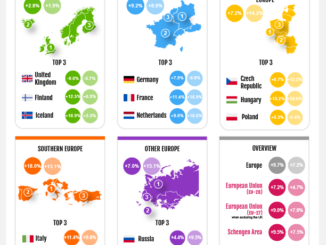
From the French countryside, dotted with idyllic small towns and inviting vineyards, to the iconic cultural institutions in London and Rome, Europe is blessed with an unending roll call of travel possibilities. And for Chinese tourists, particularly the ones that are traveling more and more to Europe, there’s a growing trend to venture beyond its greatest hits and into the hidden corners, which is not only spreading the reach of Chinese tourists, but also their spending dollars.
According to a recent report from Ctrip com International, European travel accounted for about 11 percent of all Chinese outbound tourists in 2018, making it the second most popular continent for travelers after Asia, which greatly benefits from short-haul flights that better suit shorter holidays. By comparison, the Americas only attracted 4 percent of Chinese outbound travelers last year.
Moreover, Chinese tourists spent on average $1,763 (RMB 11,823) per person on trips to Europe last year, a slight decline from the previous year, which was partly due to lower long-haul flight costs. Ctrip added, however, that customized itineraries and tours to Europe increased a whopping 147 percent year-on-year, with the average cost of such trips reaching $373 (RMB 2,500) per person per day. Ctrip also noted that almost 80 percent of its customers booked 4- or 5-star products for their trips. And more surprisingly, the “2018 Europe Travel Report” co-produced by government research institute China Tourism Academy (CTA), noted that 60 percent of Chinese tourists to the continent are women.
The data claims to reinforce the success of the EU-China Tourism Year, which significantly boosted tourism figures to some destinations such as Croatia and Hungary. While the numbers to specific countries seem impressive, overall trips to Europe have only increased 1.7 percent from 2017. To accommodate the traveler volume, there are currently more than 600 weekly flights between China and the European destinations, the report notes.
Increases in tourism to destinations like the U.K. and France have been a boon for luxury retailers who rely on tourist spending. Burberry, for example, stated in its year-end earnings release that it saw an increase in Chinese tourist spending at its U.K. stores. Such reassuring stories have been clouded by continued data indicating that Chinese tourists are shopping less in an effort to spend more on experiences while road. The slowdown in Chinese tourist shopping has not, however, deterred retailers from launching campaigns to convince travelers to spend more. Luxury retailers in Europe, such as La Rinascente in Italy and Galeries Lafayette in Paris, have been at the forefront of accepting Chinese mobile payment options like Alipay and WeChat Pay.
Some non-EU nations, including Albania and Bosnia and Herzegovina, have benefited from implementing visa-free stays for Chinese tourists over the last year, though neither country introduced the measures until spring 2018.
But the travel industry, overall, has noticed a decline in Chinese group tours over the past year, but Ctrip said that it saw a 27 percent year-on-year increase in tour bookings to Europe in 2018. The online travel agency did not, however, specify whether those tours were private, small group, or all-inclusive tours.
Meanwhile, Chinese bookings to Europe are up year-on-year for the first four months of 2019, according to travel data analysis firm ForwardKeys and the European Travel Commission. The tourist trends point to the potential for another windfall year for European destinations that cater their services to Chinese tourists — and luxury retailers are likely to benefit, as they fine-tune their campaigns for this rapidly growing and lucrative tourist segment.
By Matthew Lubin



